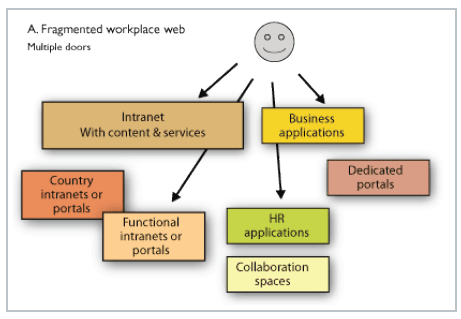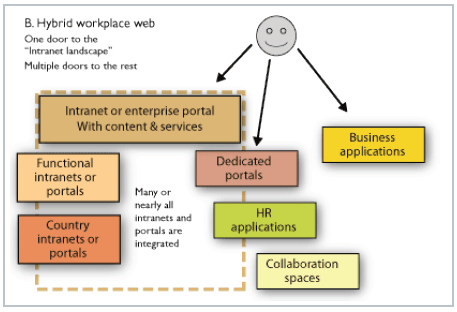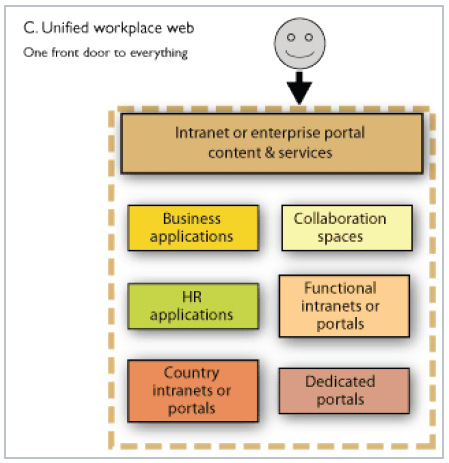Check out Global Intranet Trends 2011 (part 1)
One of the things we asked in out State of Enterprise 2.0 study (which we are releasing in a few weeks) was, “what are the business drivers of E2.0?” In her survey around Global Intranet Trends for 2011, Jane asked a similar question around what the intranet priority is for leaders of organizations. It turns out that among leaders the number one priority is around communication followed by “productivity/efficiency, collaboration/teamwork, and business needs as distant runner-ups. Communication can obviously mean a lot of different things but leaders recognize that without effective communication nothing else is going to be possible.
Inherent in this finding is the importance of these new “social” intranets which actually allow employees to communicate and collaborate with one another instead of just serving as document and information warehouses. Legacy systems allow for virtually no communication among employees which is something that leaders within organizations are realizing needs to change. One of the things I keep hearing from employees using legacy systems is that their existing intranets are where documents and information go to die.
One of the other key things in the report was the breakdown that Jane provided for the three types of workplace models which I actually found quite interesting. These three models were broken down into the fragmented, hybrid, and unified types of workplaces.
The fragmented workplace is a struggle that many organizations today are faced with. In this scenario organizations have multiple home pages usually with their own username and password. It’s very inefficient and quite time consuming to access multiple technologies from multiple sites (intranets and portals).

The hybrid workplace scenario as describe by Jane, occurs when organizations accept that an intranet is their main entry point within the organization (to get tasks done and find information). However, in this scenario the organization still has several other portal or intranet sites that employees still have to access.

Finally we have the unified workplace, this is the best case scenario for organizations as employees are able to access absolutely everything they need through their “front door” (intranet) to everything. The American Hospital Association is one of the companies that comes to mind which is working on this quite diligently.

Now, although the unified workplace is the ideal state to strive for, Jane also found that this scenario is not a reality for most companies. Based on the many conversations I have been having with companies I can say that Jane’s finding is definitely consistent with what I am hearing. Making something the “front door” for all employees within an organization (especially a large one) is a daunting if not impossible tasks. Organizations are already using so many technologies and platforms that it’s hard to imagine being able to integrate them together.
I’ll be covering some more things from the report in subsequent posts, in the meantime if you wish to participate in the 2012 report you can find that survey here, all participants get a free copy of the Digital Workplace Trends for 2012 report which will be published in October!

With more and more social apps promoting a login using a user,s FB credentials, could FB become the defacto authentication standard that gives us a single login to multiple disparate systems, networks and applications?
A number of companies are trying to plug this gap be it application centric like SAP’s DUET, or agnostic like Cisco’s QUAD or Tibco’s TIBBR. I definitely see the benefits in a single “front door” however a key point for me is that the front door is completely personalised in the enterprise. A Sales Rep’s view of the company should be different to the software developer’s view for instance. You could carve these view’s across any demographic boundaries, age, gender, have kids, social, non-social, industry type, career path.
Anything that improve’s efficiencies and increases time to information can only be a good thing.
Nice post! Thanks a lot!
Companies have not only fragmented business application and collaboration spaces, most bought technologies over time that are overlapping and often prove a roadblock in the smooth conduct of the business. A complete business technology re-engineering (BTR) and implementing a comprehensive Enterprise 2.0 solution is the answer.
Nafay
http://www.kreeo.com
Hi Scott,
It already does that for many customer grade technologies but I haven’t seen or heard of this being applied to the enterprise yet, for example logging into an intranet platform via FB credentials. I could also see that as a big security threat. Most companies already have some sort of internal director where employees have a username and password already. Instead what they do is apply single sign on capabilities (for example from a vendor such as symplified) which allow employees to use their un/pws for any enterprise applications.
Tibbr is actually doing some very interesting things. They are being referred to by several folks as the OS of the enterprise.
Agreed, Lincoln. The real challenge is to get the right balance in personalization between what is mandatory, recommended or optional for a sales rep versus an engineer, for example. Then the question becomes “who decides”. I’ve worked with many large global companies as a workshop facilitator helping in their internal “negotiations” on these questions. You get quite different responses from HQ people, regional directors, business unit managers and functional leaders (such as the Sales director). And of course, we have the person him/herself. How much individual control over the much desired personalized entry page does the user have!
Thats really cool answer to article ! Man you`re relly gourgrous!
thanks a lot for the post and for the comment! good link! thnaks!